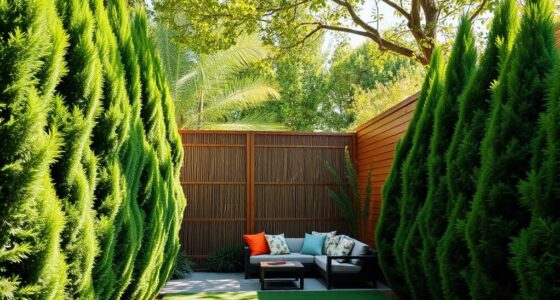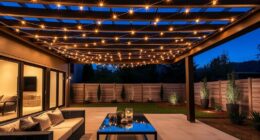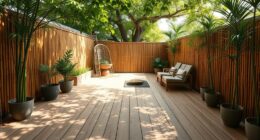Biophilic outdoor spaces featuring vertical gardens and water features help you create healthier, more peaceful environments. Vertical gardens filter indoor air and reduce noise, making your space more invigorating and quieter. Water features add calming sounds and visual beauty, fostering relaxation. These elements also strengthen your connection to nature, boosting well-being and mental health. Keep exploring to discover how combining these features can transform your outdoor area into a serene retreat.
Key Takeaways
- Vertical gardens and water features enhance outdoor spaces by improving air quality and creating lush, natural environments.
- They serve as natural sound barriers, reducing urban noise and promoting tranquility.
- Incorporating biophilic elements fosters connection to nature, boosting mental well-being and relaxation.
- These features add aesthetic appeal and functionality, transforming outdoor areas into peaceful retreats.
- They support sustainable design by filtering pollutants, increasing biodiversity, and encouraging eco-friendly practices.

Have you ever wondered how connecting with nature can boost your well-being? Incorporating biophilic outdoor spaces like vertical gardens and water features into your environment can make a noteworthy difference. These elements do more than just beautify a space—they actively improve the quality of your daily life. For instance, vertical gardens help filter indoor air, creating a healthier atmosphere inside your home or office. As plants absorb pollutants and release oxygen, they naturally purify the air you breathe. This can lead to better concentration, fewer headaches, and an overall sense of renewal. Additionally, the presence of lush greenery can reduce the amount of dust and airborne toxins, making your indoor environment cleaner and more inviting.
Connecting with nature through vertical gardens and water features enhances air quality and promotes well-being.
Noise reduction is another major benefit of integrating vertical gardens and water features into your space. Noise pollution can be a constant source of stress, especially in urban environments. Vertical gardens act as natural sound barriers, absorbing and deflecting sound waves. Their thick layers of foliage dampen noise from traffic, neighbors, or other disturbances, helping you create a peaceful sanctuary. Water features, like fountains or small streams, contribute similarly by producing soothing sounds that mask unwanted noise. The gentle trickle of water not only muffles disruptive sounds but also adds a calming auditory backdrop, making your outdoor or indoor space more serene. When combined, these features can transform a noisy, chaotic environment into a tranquil retreat.
Beyond their functional benefits, vertical gardens and water features foster a deeper connection to nature, which can remarkably enhance your mental health. The sight and sound of greenery and flowing water evoke feelings of calm and relaxation. They remind you of natural ecosystems, encouraging mindfulness and reducing stress. This connection is especially valuable if you spend a lot of time indoors. By bringing elements of the outdoors inside or creating accessible outdoor spaces, you can experience the restorative effects of nature without leaving your property. Incorporating biophilic design principles can further optimize these benefits by seamlessly blending natural elements with your living or working space. The visual appeal of lush plants and the peaceful sound of water create an inviting atmosphere that encourages you to pause, breathe deeply, and unwind.
In essence, adding vertical gardens and water features is a practical way to enhance your environment. They improve indoor air quality, reduce noise pollution, and foster a stronger bond with nature. Whether you’re designing a backyard retreat or transforming an indoor space, these biophilic elements bring a breath of fresh air into your daily routine. Not only do they elevate the aesthetic appeal, but they also support your health and well-being, making every day feel a little more natural and a lot more peaceful.
Frequently Asked Questions
How Do Vertical Gardens Affect Urban Air Quality?
Vertical gardens improve urban air quality by actively filtering pollutants and enhancing air purification. As you incorporate these green walls, they absorb carbon dioxide, trap dust particles, and reduce harmful gases, leading to cleaner, healthier air. You’ll notice less smog and improved visibility. By reducing pollutants, vertical gardens create a more pleasant environment, making urban spaces more livable and supporting overall public health.
What Maintenance Is Required for Outdoor Water Features?
Keeping your outdoor water feature in top shape is essential. You’ll want to regularly check water filtration systems to guarantee clarity and freshness, and perform pump maintenance to keep water flowing smoothly. Cleaning debris and algae, topping off water levels, and inspecting equipment help prevent issues. By staying on top of these simple tasks, your water feature remains a beautiful, soothing centerpiece with minimal fuss.
Are Biophilic Designs Suitable for All Climate Zones?
Yes, biophilic designs are suitable for all climate zones, thanks to their climate adaptability and design versatility. You can tailor these spaces to suit local weather conditions, choosing appropriate plant species and water features that thrive in your environment. This flexibility allows you to create natural, calming outdoor areas whether you’re in a temperate, arid, or tropical climate, enhancing your space’s beauty and sustainability year-round.
How Do These Spaces Impact Mental Health Benefits?
You’ll find that biophilic outdoor spaces substantially boost your mental health by promoting nature therapy and stress reduction. Spending time around greenery and water features helps calm your mind, lowers anxiety, and improves mood. These environments reconnect you with nature, offering a restorative escape from daily stressors. Incorporating vertical gardens and water features in outdoor spaces creates a soothing atmosphere that supports your overall well-being and mental clarity.
What Are Cost Considerations for Installing Vertical Gardens?
You should conduct a thorough cost analysis before installing a vertical garden, considering materials, plant selection, and ongoing maintenance. Installation challenges, such as structural support and irrigation setup, can increase costs markedly. Be prepared for higher initial expenses if your space requires specialized mounting or waterproofing. Budget wisely, and explore options like modular systems to reduce costs and simplify installation, ensuring your investment aligns with your long-term sustainability goals.
Conclusion
As you step into these biophilic outdoor spaces, you’ll find a gentle reminder of nature’s quiet grace. Vertical gardens and water features softly whisper the importance of harmony and renewal, inviting you to pause and breathe. In embracing these elements, you nurture a subtle connection to the earth’s tender beauty—an unspoken gift that nurtures your soul, offering solace amid life’s busy rhythms. Let these spaces be your quiet retreat, a gentle embrace of nature’s timeless serenity.









